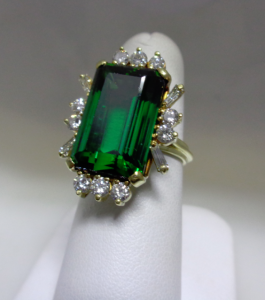Colored Gems – Tourmaline
Tourmalines are gems with an incomparable variety of colors. The reason, according to an old Egyptian legend, is that the tourmaline, on its long journey up from the center of the Earth, passed over a rainbow. In doing so, it assumed all the colors of the rainbow. And that is why it is still referred to as the ‘gemstone of the rainbow’ today. The name tourmaline comes from the Singhalese words ‘tura mali’. In translation, this means something like ‘stone with mixed colors, referring to the color spectrum of this gemstone, which outdoes that of all other precious stones. There are tourmalines from red to green and from blue to yellow. They often have two or more colors. There are tourmalines which change their color when the light changes from daylight to artificial light, and some show the light effect of a cat’s eye. No two tourmalines are exactly alike. This gemstone has an endless number of faces, and for that reason it suits all moods. No wonder that magical powers have been attributed to it since ancient times. In particular, it is the gemstone of love and of friendship, and is said to render them firm and long-lasting
In order to understand this variety of color, you will have to brush up your knowledge of gemology a little: tourmalines are mixed crystals of aluminum boron silicate with a complex and changing composition. The mineral group is a fairly complex one. Even slight changes in the composition cause completely different colors. Crystals of only a single color are fairly rare; indeed the same crystal will often display various colors and various nuances of those colors. And the trademark of this gemstone is not only its great wealth of color, but also its marked dichroism. Depending on the angle from which you look at it, the color may be different or more or less intense. It is always at its most intense when viewed looking toward the main axis, a fact to which the cutter must pay great attention when lining up the cut. This gemstone has excellent wearing qualities and is easy to look after, for all tourmalines have a good hardness of 7 to 7.5 on the Mohs scale. So the tourmaline is an interesting gemstone in many ways. In the trade, the individual color variants have their own names. For example, a tourmaline of an intense red is known as a ‘rubellite’, but only if it continues to display the same fine ruby-red in artificial light as it did in daylight. If the color changes when the light source does, the stone is called a pink or shocking pink tourmaline. In the language of the gemmologists, blue tourmalines are known as ‘indigolites’, yellowish-brown to dark brown ones as ‘dravites’ and black ones as ‘schorl’. The last mentioned, mostly used for engravings and in esotericism, is said to have special powers with which people can be protected from harmful radiation.
One particularly popular variety is the green Tourmaline, known as a ‘verdelite’ in the trade. However, if its fine emerald-like green is caused by tiny traces of chrome, it is referred to as a ‘chrome tourmaline’. The absolute highlight among the tourmalines is the ‘Paraiba tourmaline’, a gemstone of an intense blue to blue-green which was not discovered until 1987 in a mine in the Brazilian state of Paraiba. In good qualities, these gemstones are much sought-after treasures today. Since tourmalines from Malawi with a vivid yellow color, known as ‘canary tourmalines’, came into the trade, the color yellow, which was previously very scarce indeed, has been very well represented in the endless spectrum of colors boasted by the ‘gemstone of the rainbow’.
Courtesy of the International Colored Gemstone Association.
